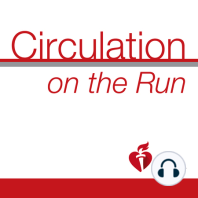17 min listen
Circulation November 24, 2020 Issue
ratings:
Length:
27 minutes
Released:
Nov 23, 2020
Format:
Podcast episode
Description
This week’s episode features author Emma Birks and Associate Editor Hesham Sadek as they discuss the article " Prospective Multicentre Study of Myocardial Recovery Using Left Ventricular Assist Devices (REmission from Stage D Heart Failure: RESTAGE-HF): Medium Term and Primary Endpoint Results." TRANSCRIPT BELOW: Dr. Carolyn Lam: Welcome to Circulation on the Run, your weekly podcast, summary and backstage pass to the journal and its editors. I'm Dr. Carolyn Lam, associate editor from the National Heart Center and Duke National University of Singapore. Dr. Greg Hundley: And I'm Dr. Greg Hundley, associate editor, director of the Pauley Heart Center of VCU Health in Richmond, Virginia. Carolyn, our feature article this week, we're going to examine myocardial recovery using left ventricular assist devices, getting some early results from the RESTAGE-HF study. But before we jump to the feature discussion, how about we discuss some of the papers in the issue? Would you like to go first? Dr. Carolyn Lam: Yes I would. Have you thought about what's the benefit of emergent coronary angiography after resuscitation from out of hospital cardiac arrest for patients without ST elevation? It's an important question. Well, the portal study was reported by Dr. Kern from University of Arizona and colleagues, and this was designed to evaluate the efficacy and safety of early coronary angiography and to determine the prevalence of acute coronary occlusion in resuscitated out of hospital cardiac arrest in patients without ST elevation. So adult comatose survivors without ST elevation after resuscitation, were prospectively randomized to early coronary angiography versus no early coronary angiography, where early was defined as less than 120 minutes from arrival at the PCI capable facility. The primary endpoint was a composite of efficacy and safety measures, including efficacy parameters of survival to discharge favorable neurological status at discharge echo measures of left ventricular ejection fraction, more than 50% and a normal regional wall motion score within 24 hours of admission. Dr. Greg Hundley: So, lots of data here. What did they find? Dr. Carolyn Lam: So, unfortunately the study was prematurely terminated before enrolling the target numbers of patients. A total of 99 patients were enrolled from 2015 to 2018 and 49 were randomized to early coronary angiography. The primary endpoint of efficacy and safety was not different between the two groups. Early coronary angiography was not associated with any significant increase in survival or adverse events. And early coronary angiography revealed a culprit vessel in 47% with a total of 14% of patients undergoing early coronary angiography, having an acutely occluded culprit coronary artery. So while this was an underpowered study, when considered together with previous clinical trials, it does not support early coronary angiography, comatose survivors of cardiac arrest without ST elevation, whether early detection of occluded potential culprit arteries leads to interventions that improve outcomes does require additional study. And this is discussed in an editorial by Dr. Lemkes from Amsterdam university medical center. Dr. Greg Hundley: Very nice Carolyn. So at least the study that points us toward the next study that has to be performed and also does with other studies provide a little more clarity. Well, my next paper is from Professor Sanjiv Shah and--oh, wait a minute! And also from you as a co-author. Well, Carolyn, how about we have a little mini feature discussion where I can ask you some questions and then you can tell us all about your paper. Dr. Carolyn Lam: Happy to. Dr. Greg Hundley: Great. So Carolyn, what hypotheses were you testing and what was your study design and who was included in your study population? Dr. Carolyn Lam: Okay. So the question was we wanted to answer was thus a systemic pro-inflammatory state as indicated by proteomic profiling. Does that mediate the assoc
Released:
Nov 23, 2020
Format:
Podcast episode
Titles in the series (100)
Circulation January 24, 2017 Issue: Circulation Weekly: Your Weekly Summary & Backstage Pass To The Journal by Circulation on the Run
